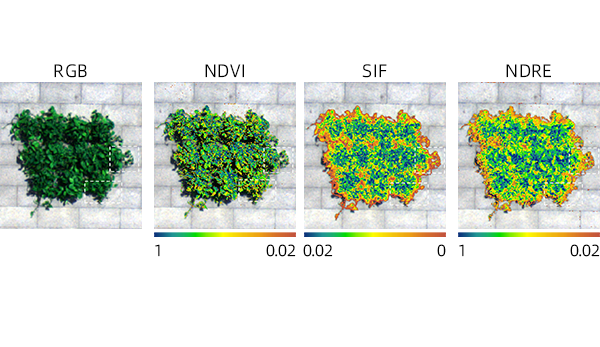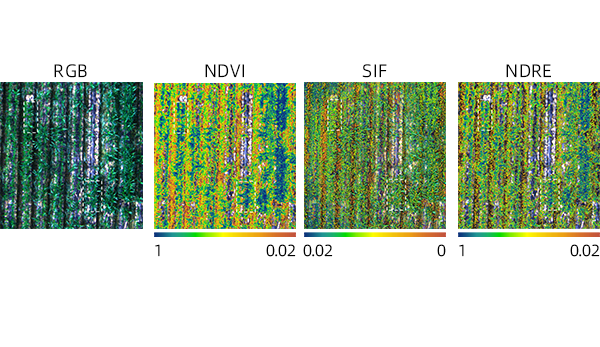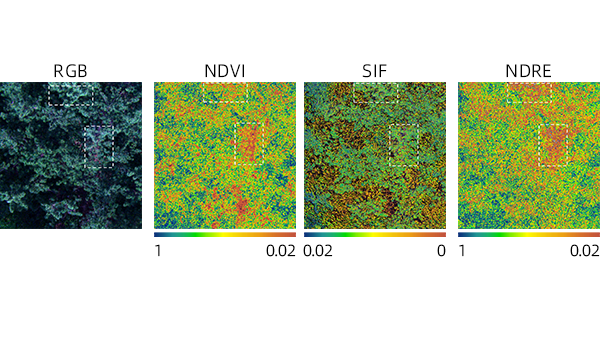8-band DJI SIF imaging multispectral Yusense FD500 Pro
This is the industry’s first frame-type SIF multispectral camera, integrating five 1.3M-pixel multispectral channels with one main SIF channel and two auxiliary SIF channels, enabling dual remote sensing and video detection modes. The SIF channel effectively addresses the industry challenges of low spatial resolution for non-imaging SIF detection and high cost for imaging hyperspectral SIF detection, making drone-mounted SIF imaging detection at the plant and leaf level possible.
It can meet the needs of scientific research applications in the field of botany, such as gene phenotyping, pathological research, breeding and resistance selection, growth process simulation, and industrial applications such as vegetation drought stress, greening growth monitoring, and agricultural and forestry disaster warning.
Solar-induced chlorophyll fluorescence (SIF) multispectral technology captures the weak fluorescence signals emitted by plant photosynthesis, providing a non-invasive monitoring method for plant phenotyping. This technology can quantify crop photosynthetic efficiency, water stress, and nitrogen status, significantly improving the efficiency of phenomic analysis in stress tolerance breeding and precision agriculture.


Solar-induced chlorophyll fluorescence (SIF) multispectral technology enables real-time, non-destructive monitoring of crop growth by detecting the fluorescence signals released by crop photosynthesis. This technology accurately quantifies photosynthetic efficiency, water stress, and nutrient status, effectively avoiding errors caused by spectral signal saturation. Its narrow bandwidth suppresses imaging noise, providing critical data support for precision agriculture and significantly improving the timeliness and accuracy of field management.
By capturing abnormal fluorescence signal changes in the photosynthetic system of stressed trees, early identification of changes in plant respiration levels caused by pests and diseases can be achieved. Its characteristic wavelengths can effectively distinguish between pest and disease stress and natural aging, providing a quantitative basis for targeted prevention and control, significantly improving the efficiency of forest health monitoring.

| Indicator name | Yusense FD500 Pro |
| Assembly method | SIF main channel + SIF auxiliary channel + 5-channel multispectral |
| Target size | SIF main channel: 1/1.6″; SIF auxiliary channel: 1/4″; multi-spectral: 1/4″ |
| Effective pixels | SIF main channel: 0.48Mpx; SIF auxiliary channel: 1.3Mpx; multi-spectral: 1.3Mpx |
| Shutter type | Multispectral channel: global; SIF primary and secondary channels: other |
| Quantization bit number | 12bit |
| Field of view | SIF main channel: 35.4°×26.9°; SIF auxiliary channel: 36.7°×31.3°; Multispectral: 36.7°×31.3° |
| Ground resolution | SIF main channel: 9.60cm@h120m; SIF auxiliary channel: 6.23cm@h120m Multi-spectral: 12.46cm@h120m |
| Coverage width | SIF main channel: 77m×58m@h120m SIF auxiliary channel: 80m×67m@h120m; multi-spectral: 80m×67m@h120m |
| Spectral channel [1] | SIF main channel ([email protected]), SIF auxiliary channel (750nm@10nm,778nm@13nm), multi-spectrum (450nm@30nm, 555nm@27nm,660nm@22nm, 7 |
| Optical window | – |
| Host size | ≤130mm×160mm×180mm |
| Host weight | ≤910g |
| Installation interface | X-Port |
| powered by | X-Port |
| Power consumption | ≤20W |
| Image Format | SIF primary/secondary channels: 16-bit original TIFF; multispectral: 16-bit process TIFF |
| Video Format | MP4 |
| Storage media | Standard 64G, maximum support 128G capacity (transmission speed U3 and above rating) micro SD card |
| Processing software | Yusense Map,Yusense Map Plus |
| Parameter settings | DJI Pilot |
| Shooting trigger | Timing trigger, overlap rate trigger |
| Shooting frequency [2] | Remote sensing photography ≤ 2Hz (related to the actual read and write speed of the storage medium); video detection ≤ 20Hz |
| Working environment temperature | -10℃~+45℃(relative wind speed ≥1m/s) |
| Storage temperature | -30℃~+70℃ |
| Ambient humidity | RH(%)≤85% (non-condensing) |
| Product Certification | CE, FCC, RoHS |
Note: [1] Standard wavelength, the following 19 wavelength combinations are allowed: full color, 410nm@20nm, 450nm@30nm, 490nm@25nm, 530nm@27nm, 555nm@27nm, 570nm@32nm, 610nm@30nm, 650nm@27nm, 660nm@22nm, 680nm@25nm, 720nm@10nm, 720nm@15nm (Qualcomm), 750nm@10nm, 780nm@13nm, 800nm@35nm, 840nm@30nm, 900nm@35nm, 940nm@30nm, (tolerance ±5nm). [2] Test results using new storage media with a transmission speed rating of U3 or above (write speed ≥ 60MB/s).
Pay securely with your Card, Apple Pay, or Google Pay via Paymob.

A payment link, also known as a checkout link, is a shareable URL that allows customers to make payments online.
Cash/Cheque payment/Bank transfer
Inquire price for Yusense FD500 Pro